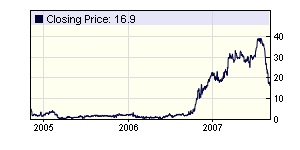What does it mean to say that “I believe that Hillary Clinton has a 42% chance to win the 2008 U.S. Presidential election?” It used to be that some academics (called “frequentists”) had problems with this statement, because they only wanted to talk about probabilities for experiments that, at least in principle, could be run many times, to permit a reasonable estimate of the frequency of some event. I think hardly anybody is a frequentist anymore.
One good operational definition of the above statement is that if you offer me a choice between $1.00 if Hillary Clinton wins, or $0.42 regardless of whether or not she wins, I am indifferent. If you offer me less than the $0.42, I’ll take the chance on Senator Clinton, if you offer me more, I’ll go with the sure thing.
Nowadays, we can get good estimates of the probabilities of many interesting events from prediction markets like TradeSports for sporting events, or Intrade for political and other events. In these markets, participants buy and sell contracts of the above variety, so that the market provides a consensus probability for a particular event.
I find these markets fascinating. You can find out for example, looking at the chart above, that Senator Obama’s apparent chance of winning the Democratic nomination has fallen from around 39% to around 17% over the last few weeks (presumably because of the fallout over his statements on foreign policy). Or that the New England Patriots off-season acquisitions have increased their chances of winning the next Super Bowl from about 7% to 17%.
There’s some bias towards American sports and politics, but events like the recent French Presidential election are also heavily traded.
I’ve just been an observer, and I intend to stay that way, but if you’re interested, but don’t want to use real money, Intrade recently began letting you play with pretend dollars.
Tags: frequentist, prediction markets, Probability, tradesports.com intrade.com

Leave a comment